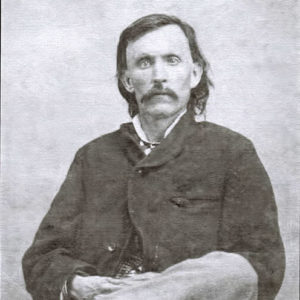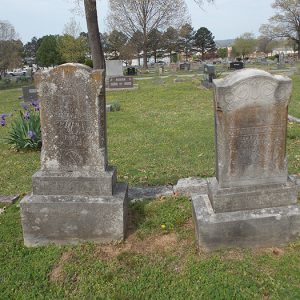calsfoundation@cals.org
William M. Lawrence (1826–1892)
William M. Lawrence was a prominent physician in Batesville (Independence County) from 1848 until his death. He was appointed the surgeon general of the state of Arkansas in 1881.
William Lawrence was born on November 22, 1826, in Kentucky, the son of James McKinney Lawrence and his first wife, Lucy D. Martin Lawrence, who was from Missouri. He had two brothers (one of them a son to his father’s second wife, Margaret Ann Vaunter Lawrence) and three sisters. Lawrence moved with his family to Fulton, Missouri, when he was a young child.
About 1843, he began “reading medicine” under Dr. Robert Blakely in Fulton. He attended medical school at the University of Missouri–St. Louis, studying under Dr. Joseph McDowell. Following graduation in 1847, Lawrence traveled to Batesville and started his own practice. His family stayed in Callaway County, Missouri, and lived in Missouri the rest of their lives.
In 1848, Lawrence married Sophia Ann Hynson, daughter of Henry Ringgold Hynson and Eliza Ann Magness Hynson, a prominent family in Batesville. Their first child, Laclede Magness Lawrence, was born in 1852. Their second, William B. Lawrence, was born in 1854. (William B. Lawrence followed in his father’s footsteps and became a prominent Batesville physician, affectionately known as “Dr. Billy,” receiving his MD from the Jefferson Medical College of Thomas Jefferson University in Philadelphia, Pennsylvania, in 1877.)
In 1855, Lawrence and his family took up residence in the historic Ringgold-Noland-Lawrence home located on lower Main Street in downtown Batesville. This had previously been the home of Sophia’s uncle, Colonel John Ringgold, and his wife, Elizabeth Spriggs Ringgold. Sophia’s sister, Mariah Louisa Hynson, married Colonel James Rutherford (Civil War hero of the Battle of Shiloh and later a state senator) in the home in December 1862.
In 1858, Independence County pioneer Robert Boyd Engles and his two brothers acquired a steamboat and named it the William M. Lawrence, one of the few steamboats built in Batesville. It is possible that Engles had known Lawrence when both studied medicine in Missouri. Engles served as pilot when the Lawrence made its maiden voyage, delivering furniture for the new Independence County Courthouse. After two years, the Engles brothers sold the Lawrence, and it was burned by Federal troops in Little Rock (Pulaski County) in 1863.
Lawrence rendered medical services both as a physician and as a surgeon for the Confederacy during the Civil War, serving with the First Regiment, Arkansas Mounted Rifles. The regiment was organized in Fort Smith (Sebastian County) in May 1861. Lawrence enlisted from Independence County. The unit fought at the Battles of Wilson’s Creek in Missouri and Pea Ridge in Arkansas. He participated in Bragg’s Kentucky campaign under General Thomas James Churchill, who later became governor of Arkansas. Lawrence was one of three members of the Trans-Mississippi Examining Board of the Confederate service. He was mustered out in the spring of 1865 and returned to his family and medical practice in Batesville.
In 1868, during the Reconstruction period, Lawrence was offered the Chair of Physiology in the St. Louis medical school by his former professor Dr. McDowell, but he opted to stay in Batesville. When the Independence County Medical Society was organized, Lawrence became its president in 1881.
Lawrence’s former Civil War commander, Thomas James Churchill, was elected governor and placed great emphasis on health and education during his administration. Under his guidance, legislation was passed setting standards for practicing medicine, and he was instrumental in establishing the Medical Department of Arkansas Industrial University (now the University of Arkansas for Medical Science—UAMS) in Little Rock. Governor Churchill appointed Lawrence surgeon general of Arkansas in 1881. Lawrence was also elected to fill the Anatomical Chair of the Medical Department at the University of Arkansas. Lawrence continued to be a respected physician and surgeon in Batesville until his death.
Lawrence died at his home in Batesville on July 13, 1892, of “stomach and heart trouble” and is buried beside his wife and family in Oaklawn Cemetery in Batesville.
For additional information:
Butler, W. Lawrence. “Batesville’s First X-Ray” Independence County Chronicle 5 (April 1964): 48–51.
Encyclopedia of the New West. Marshall, TX: United States Biographical Publishing Company, 1881.
Hinkle, C. G. “Pioneer Physicians of Batesville.” Independence County Chronicle 1 (July 1960): 44–49.
Huddleston, Duane, Sammie Cantrell Rose, and Pat Wood. Steamboats and Ferries on the White River: A Heritage Revisited. Fayetteville: University of Arkansas Press, 1998.
McGinnis, A. C. “A History of Independence County, Ark.” Special issue. Independence County Chronicle 17 (April 1976).
Kenneth Rorie
Van Buren, Arkansas
 Health and Medicine
Health and Medicine Politics and Government
Politics and Government Post-Reconstruction through the Gilded Age, 1875 through 1900
Post-Reconstruction through the Gilded Age, 1875 through 1900 William Lawrence
William Lawrence  William Lawrence Grave
William Lawrence Grave 




Comments
No comments on this entry yet.